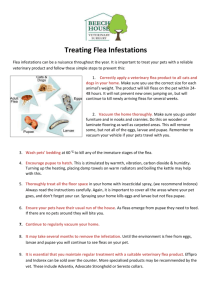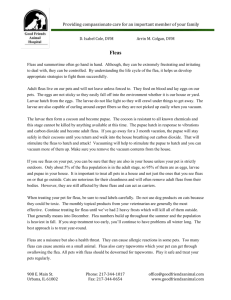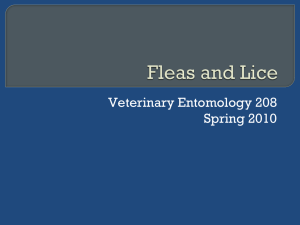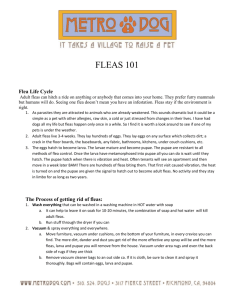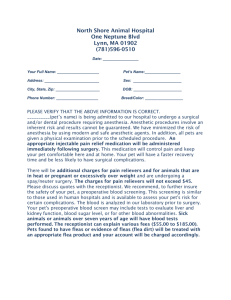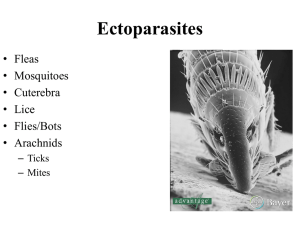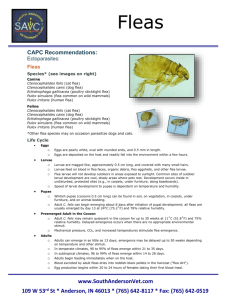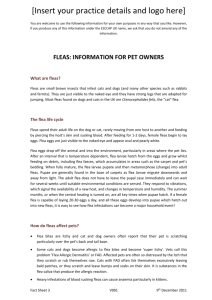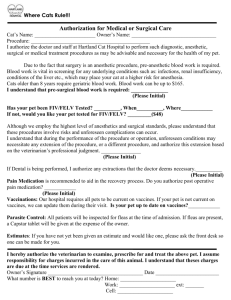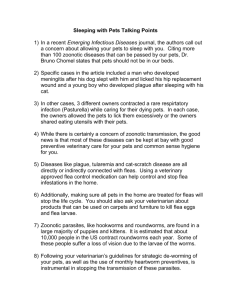Facts on F - Bloomfield Animal Hospital
advertisement
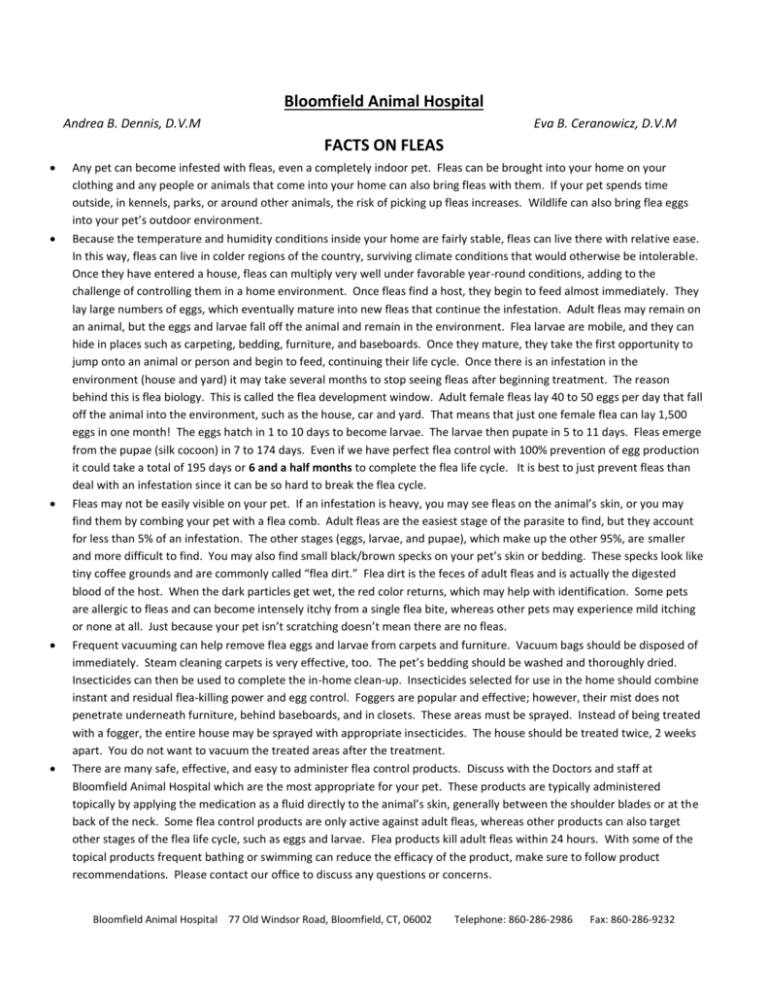
Bloomfield Animal Hospital Andrea B. Dennis, D.V.M Eva B. Ceranowicz, D.V.M FACTS ON FLEAS Any pet can become infested with fleas, even a completely indoor pet. Fleas can be brought into your home on your clothing and any people or animals that come into your home can also bring fleas with them. If your pet spends time outside, in kennels, parks, or around other animals, the risk of picking up fleas increases. Wildlife can also bring flea eggs into your pet’s outdoor environment. Because the temperature and humidity conditions inside your home are fairly stable, fleas can live there with relative ease. In this way, fleas can live in colder regions of the country, surviving climate conditions that would otherwise be intolerable. Once they have entered a house, fleas can multiply very well under favorable year-round conditions, adding to the challenge of controlling them in a home environment. Once fleas find a host, they begin to feed almost immediately. They lay large numbers of eggs, which eventually mature into new fleas that continue the infestation. Adult fleas may remain on an animal, but the eggs and larvae fall off the animal and remain in the environment. Flea larvae are mobile, and they can hide in places such as carpeting, bedding, furniture, and baseboards. Once they mature, they take the first opportunity to jump onto an animal or person and begin to feed, continuing their life cycle. Once there is an infestation in the environment (house and yard) it may take several months to stop seeing fleas after beginning treatment. The reason behind this is flea biology. This is called the flea development window. Adult female fleas lay 40 to 50 eggs per day that fall off the animal into the environment, such as the house, car and yard. That means that just one female flea can lay 1,500 eggs in one month! The eggs hatch in 1 to 10 days to become larvae. The larvae then pupate in 5 to 11 days. Fleas emerge from the pupae (silk cocoon) in 7 to 174 days. Even if we have perfect flea control with 100% prevention of egg production it could take a total of 195 days or 6 and a half months to complete the flea life cycle. It is best to just prevent fleas than deal with an infestation since it can be so hard to break the flea cycle. Fleas may not be easily visible on your pet. If an infestation is heavy, you may see fleas on the animal’s skin, or you may find them by combing your pet with a flea comb. Adult fleas are the easiest stage of the parasite to find, but they account for less than 5% of an infestation. The other stages (eggs, larvae, and pupae), which make up the other 95%, are smaller and more difficult to find. You may also find small black/brown specks on your pet’s skin or bedding. These specks look like tiny coffee grounds and are commonly called “flea dirt.” Flea dirt is the feces of adult fleas and is actually the digested blood of the host. When the dark particles get wet, the red color returns, which may help with identification. Some pets are allergic to fleas and can become intensely itchy from a single flea bite, whereas other pets may experience mild itching or none at all. Just because your pet isn’t scratching doesn’t mean there are no fleas. Frequent vacuuming can help remove flea eggs and larvae from carpets and furniture. Vacuum bags should be disposed of immediately. Steam cleaning carpets is very effective, too. The pet’s bedding should be washed and thoroughly dried. Insecticides can then be used to complete the in-home clean-up. Insecticides selected for use in the home should combine instant and residual flea-killing power and egg control. Foggers are popular and effective; however, their mist does not penetrate underneath furniture, behind baseboards, and in closets. These areas must be sprayed. Instead of being treated with a fogger, the entire house may be sprayed with appropriate insecticides. The house should be treated twice, 2 weeks apart. You do not want to vacuum the treated areas after the treatment. There are many safe, effective, and easy to administer flea control products. Discuss with the Doctors and staff at Bloomfield Animal Hospital which are the most appropriate for your pet. These products are typically administered topically by applying the medication as a fluid directly to the animal’s skin, generally between the shoulder blades or at the back of the neck. Some flea control products are only active against adult fleas, whereas other products can also target other stages of the flea life cycle, such as eggs and larvae. Flea products kill adult fleas within 24 hours. With some of the topical products frequent bathing or swimming can reduce the efficacy of the product, make sure to follow product recommendations. Please contact our office to discuss any questions or concerns. Bloomfield Animal Hospital 77 Old Windsor Road, Bloomfield, CT, 06002 Telephone: 860-286-2986 Fax: 860-286-9232
